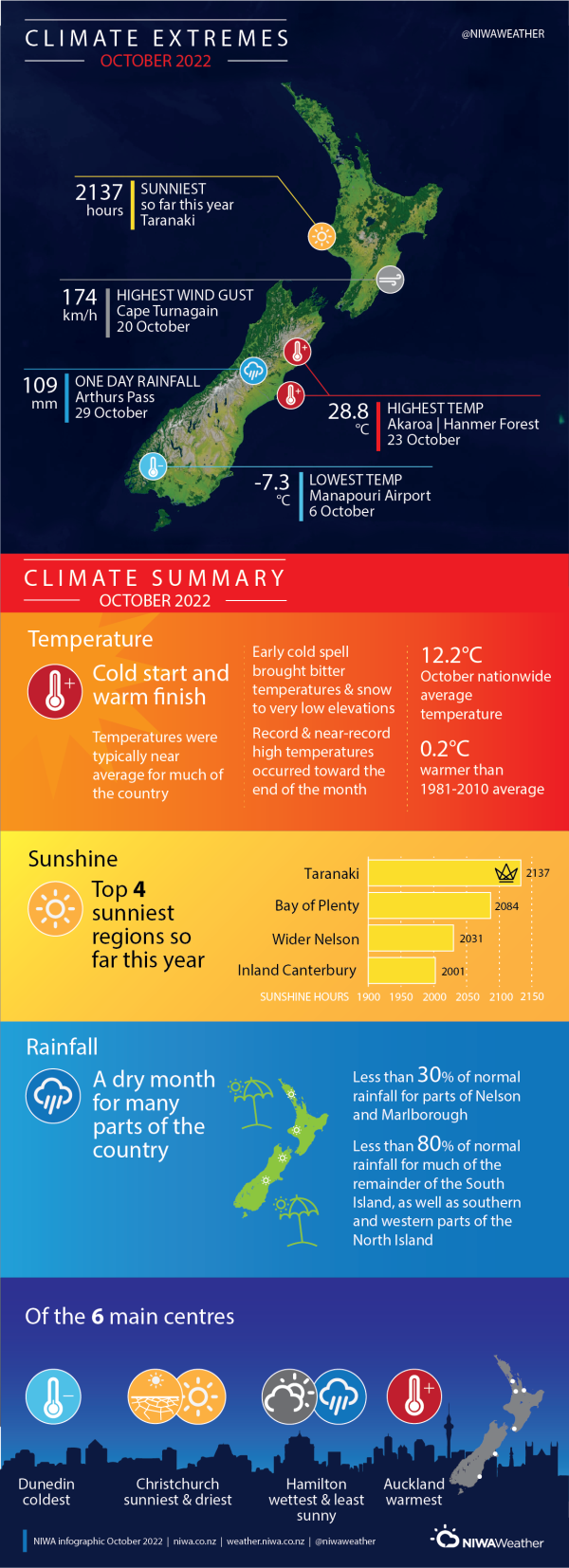A mild and dry month for much of the country
|
Temperature |
Temperatures were near average (±0.50°C of average) for much of the country, with below average temperatures (0.51°C to 1.20°C below average) for parts of the lower North Island, eastern Canterbury, and the southern South Island. Temperatures were above average (0.51°C to 1.20°C above average) in parts of Northland, Auckland, Waikato, Bay of Plenty, and the West Coast. |
|
Rainfall |
Rainfall was below normal (50-79% of normal) or well below normal (<50% of normal) for much of the South Island, southern and western parts of the North Island, and Gisborne. In contrast, rainfall was above normal (120-149% of normal) or well above normal (>149% of normal) in eastern parts of Northland, Waikato, Bay of Plenty, and inland parts of Otago and Southland. |
|
Soil Moisture |
At the end of the month, and for the time of year, soil moisture levels were lower than normal in Nelson, northern and central parts of Canterbury, and northwestern Otago. Soil moisture was higher than normal in parts of eastern Northland, Auckland, Waikato, and northern Hawke’s Bay. Soil moisture was typically near normal elsewhere. |
Overview
October 2022 was characterised by higher than normal mean sea level pressure (MSLP) over and to the southwest of Aotearoa New Zealand. Moderate La Niña conditions and a negative Indian Ocean Dipole (IOD) also continued to influence New Zealand’s climate. The Southern Annular Mode (SAM) was also positive for the majority of October. The SAM is a proxy for the location of a belt of westerly winds that encircle the South Ocean and occasionally protrude into the mid-latitudes. Usually, a positive SAM can indicate calmer and drier conditions for New Zealand.
The combination of these climate influences produced more easterly airflows than normal in the North Island, and slightly more southerly airflows than normal in the South Island. The month started on an exceptionally cold note for much of the country, as a polar southerly outbreak delivered temperatures akin to mid-winter, and snow to very low elevations (see the highlights and extreme events section for more details). In contrast, relatively high temperatures were common during the second-half of October, with record and near-record high daily maximum and minimum temperatures occurring on 23 and 29 October.
The cold start and warm end to the month resulted in near average October temperatures (±0.50°C of average) for most of the country overall. However, there were some exceptions, with pockets of relatively low and high October temperatures observed in some areas. Specifically, temperatures were below average (0.51°C to 1.20°C below average) in parts of Wairarapa, Levin, and eastern Canterbury, as well as southern and inland parts of Otago and Southland. In contrast, temperatures were above average (0.51°C to 1.20°C above average) in much of Northland, Auckland, northern Waikato, Bay of Plenty, and isolated parts of the West Coast. Overall, the nationwide average temperature for October 2022 was 12.2°C (0.2°C above the 1981-2010 October average).
Rainfall patterns across the country were mixed, although it was a relatively dry month in many parts of the country. For much of the South Island, rainfall was below normal (50-79% of normal) or well below normal (<50% of normal), although above normal rainfall (120-149% of normal) was observed about some inland parts of Otago and Southland. In the North Island, rainfall was below normal or well below normal for much of Wellington, Wairarapa, Kāpiti Coast, Manawatū, southern and inland Taranaki, and Gisborne. Rainfall was above normal or well above normal (>149% of normal) in eastern parts of Northland, inland and eastern parts of Waikato, and western Bay of Plenty.
Further Highlights:
- The highest October temperature was 28.8°C, observed at Akaroa and Hanmer Forest on 23 October.
- The lowest October temperature was -7.3°C, observed at Manapouri Airport on 6 October.
- The highest 1-day rainfall was 109 mm, recorded at Arthur’s Pass on 29 October.
- The highest wind gust was 174 km/h, observed at Cape Turnagain on 20 October.
- Of the six main centres, Auckland was the warmest, Christchurch was the driest and sunniest, Hamilton was the wettest and least sunny, and Dunedin was the coldest.
- Of the available, regularly reporting sunshine observation sites, the sunniest four regions in 2022 so far are Taranaki (2137 hours), Bay of Plenty (2084 hours), Wider Nelson (2031 hours), and inland Canterbury (2001 hours).
Download
- Climate Summary October 2022 [PDF 490 KB]
- Climate Statistics October 2022 [PDF 158 KB]


